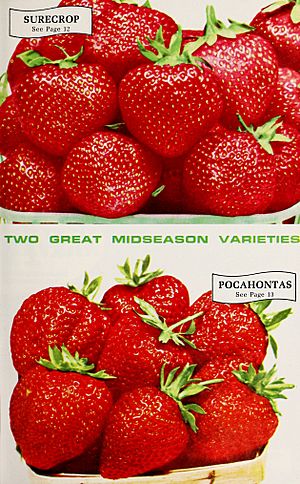Maryland cultivation of strawberry facts for kids
The state of Maryland grows many different crops, and one of the most popular is the strawberry (Fragaria × ananassa). These sweet, red fruits are enjoyed by many people.
Contents
Growing Strawberries in Maryland
In 2017, farmers in Maryland grew strawberries on about 210 acres (85 ha) of land. You can find strawberry farms in all of Maryland's counties and even in the City of Baltimore.
Protecting Strawberry Plants from Diseases
Just like people, plants can get sick! Strawberries in Maryland can face several common diseases.
Gray Mold
One common problem for strawberries is a disease called Gray Mold. This mold is found all over the world. Sometimes, the mold can become resistant to the special medicines (called fungicides) that farmers use to stop it. This means the medicines don't work as well anymore. Scientists have found that some Gray Mold in Maryland is resistant to certain fungicides.
Other Plant Diseases
Scientists have also found other types of resistance in strawberry diseases in Maryland. This means that some diseases are getting harder to control with common treatments.
In the 1990s, researchers at the USDA ARS Beltsville center did a lot of work on tiny plant germs called phytoplasma. They were the first to find two specific types of phytoplasma, called Clover Yellow Edge and STRAW B2, in Maryland's strawberries. STRAW B2 had only been found in Florida before this!
Another common problem for strawberry plants is called Black Root Rot. This disease makes the roots of the plant sick. It's thought to be caused by several different germs working together.
How Farmers Protect Strawberries
To keep strawberry plants healthy, farmers sometimes need to use special sprays. The University of Maryland Extension helps farmers by recommending certain products.
Fungicides
Fungicides are sprays that help stop plant diseases like mold. Some of the recommended fungicides include Lime sulfur, JMS Stylet Oil, Kocide, Captan, Thiram, Sulfur, Rally, Pristine, Elevate, Switch, Phostrol, and Ph-D.
Insecticides
Insecticides are sprays that help protect plants from harmful bugs. Some recommended insecticides are Provado Admire or Actara, Brigade, Malathion, and Sevin.
It's important to know that these sprays are recommended for many small fruits, not just strawberries. They also help protect plants like blackberries, raspberries, blueberries, and grapes.
Other resources


